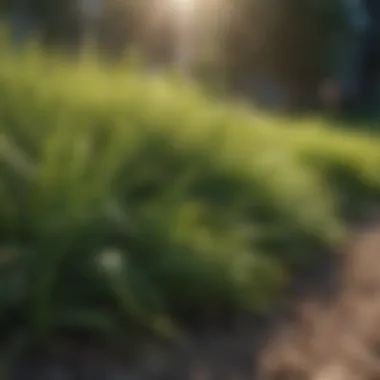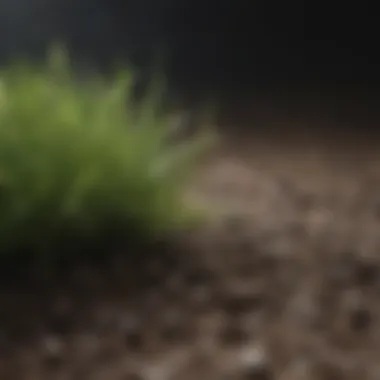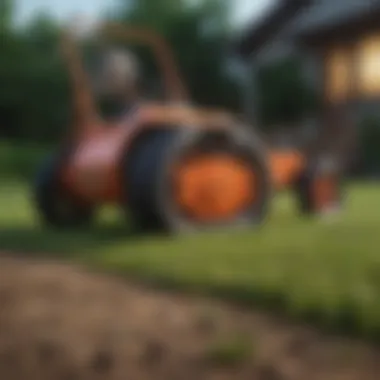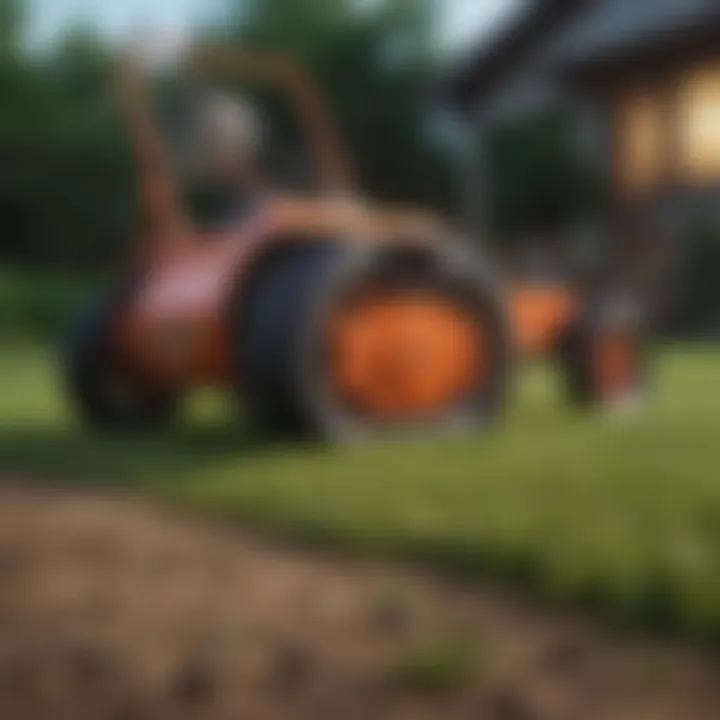Effective Strategies for Overseeding Your Lawn


Intro
Homeowners often contemplate the best ways to rejuvenate their lawns, and overseeding is a common practice that surfaces. When considering overseeding, many wonder about the ease of simply throwing down grass seed onto an existing lawn. However, this method requires a deeper understanding to achieve effective and lasting results. This article will examine the nuances of overseeding, including the necessary preparations, timing, methods, and potential challenges associated with this gardening technique.
Understanding Overseeding
Overseeding involves applying grass seed to an existing lawn to improve its density and overall health. This method is particularly beneficial for areas showing signs of wear or thinning. While the idea of just scattering seed may seem appealing, several factors can affect the success of this process.
Benefits of Overseeding
Overseeding can help restore a lush appearance to your lawn. Some of the benefits include:
- Enhanced lawn density, reducing weeds
- Improved resilience to diseases and pest infestations
- Increased tolerance to drought conditions
"A thick lawn not only looks better but also indirectly benefits the overall ecosystem."
Soil Preparation
One critical aspect that impacts the success of overseeding involves proper soil preparation. Simply scattering seed onto the grass can lead to ineffective results. Here are some steps to follow to prepare the soil effectively:
- Mow the existing grass: Cut your lawn to the shortest height possible without scalping. This excess grass can hinder seed-to-soil contact.
- Rake the lawn: Use a thatch rake to remove any debris or dead grass. This helps expose the soil and improves seed germination.
- Aerate the soil: Aerating allows for better seed-to-soil contact and improves water infiltration and nutrient absorption.
Timing Considerations
Timing plays a crucial role in lawn care. For overseeding, the ideal timing depends on your grass type. Cool-season grasses should be overseeded in late summer or early fall, while warm-season grasses prefer late spring. Proper timing ensures that seeds establish well before harsh weather conditions set in.
Effective Methods for Overseeding
Executing the overseeding process correctly is essential. Here’s a streamlined approach to follow:
- Choose the right seed: Select a grass seed that suits your climate and the existing lawn.
- Distribute the seed evenly: You can use a handheld spreader to ensure even distribution, avoiding clumping.
- Lightly water the area: Once the seeds are down, lightly water the area to promote germination without washing the seeds away.
Maintenance Post-Overseeding
After overseeding, proper maintenance is needed to promote healthy growth:
- Water regularly: Ensure consistent moisture for the newly germinated grass.
- Limit foot traffic: Avoid walking on the newly seeded area to prevent soil compaction.
- Mow wisely: Wait until the new grass reaches about three inches in height before mowing for the first time.
Challenges to Consider
Overseeding is not without its challenges. Some potential issues include:
- Competition from existing grass: Existing grass may compete for nutrients and water.
- Seed washout: Heavy rains can wash away seeds, leaving bare patches.
- Pest problems: Newly germinated grass can attract unwanted pests.
Closure
The act of overseeding an existing lawn is often not just about throwing down seeds. It involves preparation, timing, and mindful post-care. When done with care and consideration, overseeding can transform your lawn from lackluster to vibrant. Understanding this process allows homeowners to make informed decisions, ultimately fostering a healthier and more appealing outdoor environment.
Prolusion to Overseeding
Overseeding is a vital practice for maintaining and enhancing the health of an existing lawn. This process can rejuvenate tired grass and make the overall landscape more vibrant. Understanding overseeding provides homeowners with the knowledge needed to keep their lawns lush and attractive. It involves distributing grass seed over a matured lawn to improve its density and durability.
Definition of Overseeding
Overseeding is defined as the process of sowing grass seed directly onto the current lawn without disturbing the soil or tearing out old grass. This approach adds new grass varieties or reinforces existing types. It is particularly useful when aiming to cover up bare patches or to refresh a lawn that has suffered from a harsh winter or pest damage. The primary goal is to promote a thicker and healthier lawn, which can provide numerous aesthetic and practical benefits.
Why People Overseed Lawns
There are several reasons why homeowners choose to overseed their lawns. Some of the most common reasons include:
- Improving Aesthetics: A lush, green lawn enhances curb appeal and can increase property value.
- Combating Thinning Grass: Over time, lawns may thin out due to wear, climate, or diseases. Overseeding helps fill in these areas.
- Weed Control: A thick lawn can outcompete weeds for resources, thus reducing their presence.
- Introducing Improved Varieties: With advancements in grass genetics, overseeding allows homeowners to introduce newer, more resilient grass types that are better suited for their specific climates or uses.


Overall, overseeding is an effective strategy for lawn care that can yield impressive results when done correctly.
The Science Behind Grass Growth
Grass growth is a complex process that involves various biological and environmental factors. When overseeding, understanding these elements can lead to better outcomes. Here are key aspects to consider:
- Photosynthesis: Grass, like all plants, relies on sunlight to produce energy. Healthy grass requires ample sunlight to grow robustly. If the lawn is overcrowded or the grass type is too dense, it may not receive sufficient light.
- Water Uptake: Grass roots absorb water from the soil, which is crucial for growth. Proper watering techniques post-overseeding ensure that the seeds germinate successfully and establish roots quickly.
- Nutrient Availability: Nutrients from the soil play an essential role in grass health. A soil test can help inform homeowners about necessary fertilization needed to support the new grass.
To maximize the benefits of overseeding, it is important to understand the science that facilitates healthy grass growth. By applying this knowledge, homeowners can make informed decisions that enhance their lawn's health.
Assessing Your Lawn's Condition
Assessing the condition of your lawn is a crucial step in determining whether overseeding is a viable option. Understanding the health and specific needs of your lawn helps to make informed decisions about seed selection and application techniques. A thorough assessment can pinpoint existing problems, reveal growth potential, and set a baseline for future maintenance. This process also ensures that any overseeding efforts align with the characteristics of your grass type and soil conditions.
Identifying Areas of Concern
To effectively assess your lawn, start by identifying areas of concern. Look for patches that appear thin, brown, or bare, which may indicate underlying issues such as disease, pests, or insufficient moisture. Not only do these areas detract from the overall aesthetic of the lawn, but they can also affect grass health in surrounding areas. Additionally, monitor for signs of weed growth, which may compete with newly seeded grass.
It's advisable to walk through the lawn to visually inspect it closely. Mark irregular patches or spots that seem more problematic. Take note of any patterns, such as areas suffering more in shaded sections versus sunny spots. These observations can guide you in addressing specific needs during the overseeding process.
Determining Grass Type Compatibility
Knowing what type of grass is in your lawn influences your overseeding efforts. Each species has distinct growth patterns, moisture needs, and sunlight preferences, which may affect their success when intermingled. For instance, Kentucky bluegrass thrives in cooler climates, while Bermuda grass prefers warmer environments. Mixing incompatible grass types might lead to poor growth and unbalanced appearances.
Researching regional grass varieties ensures proper selection. If you are unsure about your existing grass type, you may consider contacting a local extension service or utilizing online resources such as en.wikipedia.org for referrals. Compatibility not only affects the visual appearance, but also the overall resilience and health of your lawn.
Evaluating Soil Health
Soil health plays a vital role in the success of any overseeding endeavor. Nutrient-rich soil fosters effective grass growth, while compacted or depleted soil can hinder seed establishment. Conducting a soil test reveals pH levels and the presence of essential nutrients like nitrogen, phosphorus, and potassium. Many local agricultural extensions offer testing services, or you can purchase a home soil testing kit.
It's also essential to examine the soil texture and drainage. Sandy soils provide good drainage but may require more frequent watering and fertilization, while clay soils retain moisture but can become compacted. Addressing soil health through necessary amendments, like compost or fertilizers, supports a healthier environment for your grass seed to germinate and thrive.
In summary, assessing your lawn's condition involves identifying problems, understanding grass type compatibility, and evaluating the soil health. This thorough approach ensures that the overseeding process is tailored to the specific requirements of your lawn, maximizing its chances of success.
Methods for Overseeding
Understanding the methods for overseeding is crucial for ensuring a successful application of grass seed. Overseeding can help improve lawn density, introduce new grass varieties, and enhance the overall health of the lawn. However, just throwing grass seeds down without proper methods can lead to uneven growth and wastage of resources. Here are key elements to consider:
- Timing: Knowing when to overseed is vital. The best timing can vary based on geographical location, grass type, and seasonal conditions. Overseeding at the right moment allows seeds to germinate effectively.
- Environmental Conditions: The environment plays a huge role. Factors such as soil temperature, moisture levels, and weather can influence seed germination and growth. Ensuring ideal conditions can significantly increase the chances of success.
- Application Techniques: The way seeds are distributed impacts their ability to settle into the soil. Different techniques yield different results depending on the lawn's condition.
Overall, methods for overseeding directly affect the effectiveness of the process. Attention to these elements can result in a lush and thriving lawn.
Choosing the Right Timing
Timing is a critical factor in the overseeding process. Grass seeds typically need specific conditions to germinate. Fall is widely regarded as the optimal time to overseed cool-season grasses. During this period, soil temperatures are conducive for seed germination. Additionally, the warm sun coupled with cooler nighttime temperatures create an environment where grass thrives.
In contrast, spring overseeding may be suitable for warm-season grasses. At this time, the warming soil promotes robust growth. It is also important to avoid overseeding during extreme weather conditions, such as prolonged droughts or heavy rains, which can hamper seed establishment.
Ideal Conditions for Seed Distribution
For effective overseeding, it is essential to consider ideal conditions for seed distribution. The soil should be slightly moist but not soggy. This balance ensures that seeds can settle without being washed away. Seed application is best performed either early in the morning or late in the afternoon when temperatures are cooler and there is less evaporation.
Before applying the seeds, ensure that the lawn is free of debris. Clearing leaves, twigs, and other materials allows for direct contact between the seeds and soil, improving the chance of successful germination. Wind can also play a role; a calm day is preferred to prevent the seeds from blowing away or being unevenly distributed.
Techniques for Effective Seed Application
Effective seed application can involve a variety of techniques. A common method is to use a broadcast spreader, which provides uniform distribution of the seed across the lawn. This even approach minimizes bare spots and helps in achieving consistent coverage.
Alternatively, hand broadcasting can be effective for smaller areas. In this method, seeds are thrown by hand while walking over the lawn. This requires more effort and care to avoid clumping.
After application, it is essential to lightly rake the area or use a roller to ensure seeds make good contact with the soil. This aids in protecting the seeds from birds and helps retain moisture.


"Proper techniques not only foster seed germination but can save time and effort in the long-term upkeep of the lawn."
By incorporating these methods into your overseeding process, you set your lawn up for enhanced growth and resilience.
Soil Preparation Techniques
Soil preparation is a critical step in the overseeding process. It sets the foundation for successful grass growth and improves the chances of seed germination. A well-prepared soil allows for better seed-to-soil contact, which is essential for the seeds to take root. Neglecting this step can result in uneven growth, poor density, and ultimately a lawn that does not thrive as intended.
Aerating the Lawn
Aeration involves perforating the soil with holes to improve air exchange, water infiltration, and nutrient distribution. This process reduces soil compaction, which is common in lawns that receive regular foot traffic or have heavy clay soils.
Benefits of Aerating include:
- Enhanced Root Growth: Aeration helps the grass roots to expand deeper into the soil, access moisture, and nutrients more effectively.
- Improved Drainage: By breaking up the compacted soil, aeration allows excess water to drain away more easily, reducing the risk of waterlogging.
- Reduced Thatch Buildup: Thatch can suffocate grass and inhibit growth; aeration helps to alleviate this accumulation.
To aerate your lawn, consider using a core aerator, which removes plugs of soil rather than just creating holes. This allows for better conditions for overseeding.
Mowing Before Overseeding
Mowing the lawn ahead of overseeding is an essential preparation step. Lowering the height of the grass has several advantages when overseeding.
Reasons to mow before overseeding:
- Increased Light Penetration: Shorter grass allows sunlight to reach the new seeds more effectively, which is crucial for germination.
- Reduced Competition: Mowing reduces the existing grass’ competition for resources like light, water, and nutrients.
- Easier Seed Application: A freshly mowed lawn enables the seeds to settle into the soil better, ensuring optimal seed-to-soil contact.
Aim to mow the grass to a height of about two to three inches before you apply the seeds. Make sure to collect clippings that can impede seed growth.
Topdressing with Compost
Topdressing involves applying a thin layer of compost or a soil mix on the lawn after it has been seeded. This is a beneficial practice in overseeding and helps to create a richer growing environment for the new grass.
Advantages of topdressing include:
- Nutrient Boost: Compost adds organic matter and nutrients to the soil, fostering healthier grass growth.
- Moisture Retention: A compost layer can help retain moisture in the soil, providing a suitable environment for the seeds post-application.
- Improved Soil Structure: Over time, compost can improve soil aeration and drainage, further enhancing lawn health.
While applying the compost, ensure that it is not more than a quarter-inch thick to avoid smothering the existing grass. This practice can significantly aid in the ongoing nourishment and support of the newly seeded areas.
Post-Application Care
Post-application care is crucial when it comes to overseeding your lawn. Properly managing this phase can significantly influence the success of your overseeding efforts. The initial days and weeks after sowing new grass seed are critical as the young grass is vulnerable to various factors. Understanding the post-application care components is essential for ensuring your new grass establishes well and thrives for the long term.
Watering Considerations
Watering is a fundamental aspect of post-application care. Newly spread grass seed requires consistent moisture to germinate properly. When overseeding, the seed needs to be moistened without being waterlogged. Over-saturation can lead to seed rot or fungal issues, so careful monitoring is needed.
- Frequency: Initially, water lightly once or twice daily for the first couple of weeks. This may depend on weather; a dry climate might require more frequent watering.
- Amount: Aim to moisten the top half inch of soil where the seeds lie. As the seedlings grow, gradually reduce watering frequency but increase the amount of water at each session to encourage deeper root growth.
By establishing strong watering practices, you will help ensure germination and early growth of healthy grass.
Fertilization Practices
Selecting the appropriate fertilization practices post-overseeding can enhance the grass's vitality. Fertilizing too soon or with the wrong type of fertilizer can harm the new growth.
- Timing: Wait until the new grass seedlings are about three inches tall before applying any fertilizer. This gives them time to establish roots.
- Type: Use a starter fertilizer that is high in phosphorus. This promotes strong root development, beneficial especially for young grass.
- Application: Follow the manufacturer’s instructions regarding amounts and spreader settings, ensuring even distribution. Fertilizing effectively stimulates growth and supports the overall health of your lawn.
Mowing and Maintenance Strategies
Mowing remains an integral part of maintaining an overseeded lawn. Proper mowing promotes healthy growth patterns and weed control.
- Timing: Don’t mow until the new grass reaches at least three to four inches tall. This helps avoid stress on young seedlings.
- Height: Set your mower blade high. Cutting too short can shock the seedlings. An ideal height encourages photosynthesis and healthier grass.
- Regular Maintenance: Keep a close eye on the lawn during the following weeks. Regular monitoring for weeds or pests is crucial. Removal of weeds should be done manually or with appropriate methods, taking care not to disturb the young grass.


In summary, post-application care is vital to the success of overseeding. By properly watering, fertilizing at the right time, and adhering to correct mowing and maintenance strategies, lawn owners can foster a lush, healthy landscape that enhances their overall outdoor experience.
Challenges and Solutions
The journey to a lush, vibrant lawn through overseeding does not come without its challenges. Understanding these hurdles is essential for any homeowner or gardening enthusiast aiming for successful results. The primary challenges include weed competition, pest management, and environmental factors. Each of these elements can significantly influence the effectiveness of overseeding and the overall health of the lawn. In the following sections, we will explore these challenges in depth and discuss solutions that can be employed to mitigate their impact.
Weed Competition
Weeds present a formidable challenge when overseeding. These resilient plants compete with the newly sown grass for resources such as nutrients, water, and sunlight. If left unchecked, weeds can choke out seedling grass, leading to patchy or unsuccessful growth. The most common type of weeds include crabgrass, dandelions, and clover, which often thrive in turf areas.
To tackle weed competition, pre-emergent herbicides can be used before overseeding. These products inhibit the germination of weed seeds while allowing grass seeds to establish. Additionally, regular weeding, either by hand or with gardening tools, can help maintain a clear space for grass growth. Introducing a robust fertilization program post-overseeding also aids in thickening the grass, making it more competitive against weeds.
Pest Management
Pest management is another critical aspect of lawn care that can affect overseeding success. Common pests, such as grubs and chinch bugs, can damage existing grass and hinder the growth of newly seeded areas. These pests often thrive in unhealthy lawn environments, leading to increased vulnerability.
To manage pest issues, it is crucial to conduct regular inspections of the lawn. Identifying pest problems early can lead to more effective treatment options. Natural predators like birds can help control insect populations. However, for severe infestations, targeted insecticides may be necessary. Choosing products that are safe for both the lawn and the environment is advisable.
Environmental Factors
Environmental factors also play a significant role in the outcomes of overseeding endeavors. Temperature, moisture levels, and sunlight can all affect seed germination and grass growth. For instance, too much heat may dry out seeds, while insufficient light can prevent seedlings from thriving.
To navigate these challenges, timing is critical. Overseeding should ideally take place during moderate weather conditions. This means avoiding extreme heat or cold. Watering practices also change according to the weather, as newly planted seeds require consistent moisture to sprout effectively. Additionally, understanding the specific environmental conditions of the area can lead to more informed decisions regarding grass types and maintenance practices.
"The key to a successful overseeding experience lies in addressing the challenges head-on and implementing tailored solutions that enhance growth potential."
Evaluating Overseeding Success
Evaluating the success of an overseeding project is crucial for homeowners and lawn care enthusiasts alike. It allows one to determine if the methods used were effective and if the lawn is progressing toward the desired outcomes. Understanding the indicators of successful overseeding helps ensure that optimal conditions were met for grass growth, ultimately leading to a healthier and more vibrant lawn.
Signs of Healthy Growth
After overseeding, one of the first aspects to observe is the emergence of new grass shoots. Healthy growth can typically be identified by the following signs:
- Color: New grass should appear bright green, indicating robust health and adequate nutrient uptake.
- Height: The grass blades will begin to grow taller and bushier. If they are thin or spindly, issues might be present.
- Vigor: The grass should demonstrate resilience, bouncing back from foot traffic and environmental stresses.
It is important to note that newly overseeded grass may take time to establish. Patience is essential during this observation period, usually spanning several weeks. Regular checks will help catch any potential problems early, such as patchy growth or a pronounced lack of density, suggesting the need for adjustments in care.
Assessing Grass Density
Grass density is another vital metric in evaluating overseeding success. High density indicates a well-established lawn that can better resist weeds and pests. To assess this, consider the following factors:
- Visual Inspection: Look for uniform coverage across the lawn. Sparse areas may require further examination or additional overseeding efforts.
- Physical Texture: Dense grass feels lush and thick underfoot. An area that feels thinned out might need attention.
- Weed Presence: A low-density lawn is more susceptible to weed infiltration. Consequently, a healthy, dense lawn performs better against weed encroachment.
A density analysis can lead to insights into whether you need to adjust watering or fertilization practices to bolster growth where it may be lacking.
Long-Term Lawn Health Improvement
The long-term health of a lawn after overseeding depends on multiple factors. Initially, you might notice improvements in coverage and resilience. However, to ensure sustainability, monitor these aspects over time:
- Soil Aeration and Nutrients: Assess whether the soil is retaining enough moisture and nutrients, which are critical for sustaining grass health.
- Maintenance Practices: Keep to a regular routine of mowing, watering, and fertilization based on specific grass types. Adjustments in care can lead to significant overall health improvements.
- Seasonal Changes: Observe how the lawn adapts through different seasons, as this can reveal long-term strengths and weaknesses.
By focusing on these metrics, homeowners can gather valuable insights into how well their overseeding strategy has performed. Corrective actions can be undertaken rigorously, ensuring the lawn maintains its health and beauty for years to come.
"A successful overseeding project not only transforms your lawn but enhances its resilience to environmental challenges."
Regular evaluations will provide clarity and direction for ongoing lawn care efforts, paving the way for a lush and thriving outdoor space.
Epilogue
Overseeding is a vital process for maintaining a lush and healthy lawn. This article delved into the principles and practices surrounding overseeding, shedding light on its multifaceted nature. Understanding why one should overseed, how to adequately prepare the lawn, and recognizing signs of success are all important elements that connect to the broader context of lawn care.
Recap of Key Points
The article covered several critical aspects:
- Definition and Benefits: Overseeding helps to rejuvenate tired, worn-out lawns and introduces new grass varieties that can enhance the overall health and appearance of the lawn.
- Soil Preparation: Proper soil preparation lays the groundwork for successful seed germination; aeration and topdressing were emphasized as effective methods.
- Post-Application Care: Watering and fertilization strategies directly influence the success of overseeding, making them worthy of attention.
- Challenges: Identifying potential weed competition and pest issues can prevent setbacks in achieving a healthy lawn. Lastly, ongoing maintenance forms the backbone of long-term lawn vitality.
Final Thoughts on Overseeding
Deciding whether to overseed requires careful consideration of your lawn's condition and specific planting goals. Thrown grass seeds may result in poor outcomes if not performed correctly. Thus, systematically following the procedures outlined in this article will better ensure a successful overseeding experience. Embracing these techniques will ultimately lead to a healthier, thicker lawn that enhances your outdoor space. The benefits reach beyond aesthetics, as a robust lawn can improve soil health, promote biodiversity, and contribute to a more sustainable environment.







